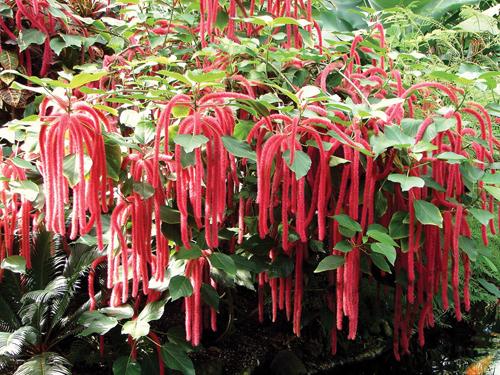Phuket Gardening: Alpha shrubs start with ‘A’

PHUKET: Last week we considered annuals, but today it is the turn of their big brothers – the shrubs and ornamental trees that form the backbone of any tropical garden (click here for last week’s article).
Acalypha hispida, also known as the chenille plant or red cat’s tail, is alphabetically the first to come under scrutiny. Unlike its cousin, A. wilkesiana or Jacob’s coat, which is grown entirely for its unique, multi-colored foliage, hispida has conventional leaves, but the most unconventional of flowers – masses of long crimson catkins which hang down beneath the foliage. These blooms feel soft and velvety to the touch – hence the colloquial name of cat’s tail.
It is a tolerant plant which will put up with poor soil, provided you give it a sunny position and a reasonable supply of water. Granted the right conditions, it will bloom freely all year round. The only proviso is that it may need pruning, since it can become leggy. Often used as an informal hedge or in dramatic groups, the chenille plant is one of the best starter plants for the inexperienced gardener. It is also easily propagated from cuttings.
Another distinctive shrub, but far removed from the chenille plant in appearance, is the adenium obesum or desert rose. Also a favorite with Thais, the adenium is basically a desert plant, a succulent which stores water in its thick, knobbly, sometimes leafless stems. Indeed for some growers, these grey, distended stems are the principal attraction, though it does produce trumpet shaped flowers and club-shaped, glossy foliage. Rarely grown in open beds, the desert rose is usually found in rock gardens or containers. An ideal choice for a pot since it will thrive in dry conditions. An occasional drenching is all it requires. In fact the adenium is much more likely to succumb to over-watering (which leads to stem and root rot) than to under-watering. If you do plant it out, the desert rose is a perfect candidate for a xeric regime.
In Thailand the desert rose has been extensively hybridized: the common pale pink, plumeria-like flowers, which appear on rather gaunt branches, now often superceded by more dramatic white, cream edged with deep crimson, or vivid red blooms. Horticulturalists tend to prune top growth to encourage flowering, but in truth, the plant is such a slow grower that it is often treated as a bonsai specimen. Personally I would let well alone unless it becomes too leggy. Propagate from calloused cuttings left overnight to dry out.
When I drew up a list of top twenty shrubs a couple of years ago, the allamanda topped the list. I have no reason to change that opinion. It wins on many counts: one, as a beautiful flowering shrub possessing huge yellow trumpets with a golden center; two, because it is tolerant of almost any conditions; three, because it has attractive glossy evergreen foliage which is a perfect foil for the flowers; and four because it seems immune to disease of any kind.
At the height of the recent driest season for years, it continued to bloom and bloom. If the allamanda has a fault, it is that although technically a vine, it does not produce tendrils, so it is unable to attach itself to adjacent surfaces. The whole luxurious structure of branches, stems, leaves and flowers, can easily become top heavy without support of some kind. But trained to a trellis or tied to a wall, it looks magnificent.
There is also a yellow, bushy variety with narrow leaves and smaller blooms, often used as a roadside border plant, and a dusty pink variety, A. blanchetti which does twine more effectively, but lacks the dramatic impact of its golden cousin.
What of more ‘A’s such as acacias, and abutilons?
Well, they will have to wait in the wings for another time.
If you have a question or a garden that you would like featured, you can email the author here.
Keep checking our online Phuket Lifestyle pages and join our Facebook fan page for regular gardening features and tips.
This article appears in the current (May 18-24, 2013) issue of the hard-copy Phuket Gazette newspaper, now on sale at newsstands throughout the island. Digital subscribers may download the full newspaper, this week and every week, by clicking here.
— Patrick Campbell
Leave a Reply
You must be logged in to post a comment.








